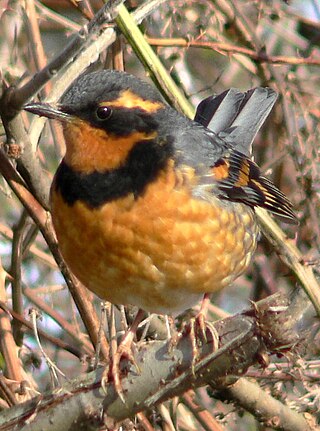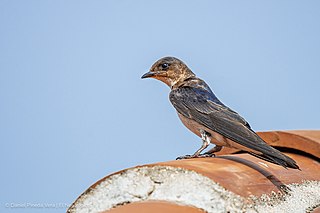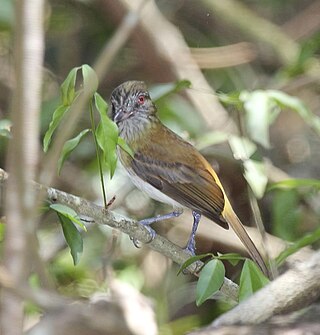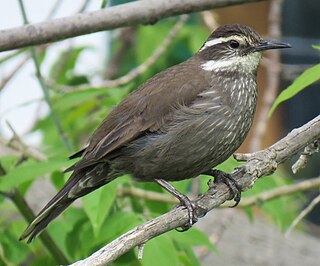
The eyebrowed thrush is a member of the thrush family Turdidae. It breeds in dense coniferous forest and taiga eastwards from Siberia and Mongolia to Japan. It is strongly migratory, wintering south to China and Southeast Asia. It is a rare vagrant to western Europe.

The varied thrush is a member of the thrush family, Turdidae. It is the only species in the monotypic genus Ixoreus.

The Pacific swallow is a small passerine bird in the swallow family. It breeds in tropical southern Asia and the islands of the south Pacific. It is resident apart from some local seasonal movements. This bird is associated with coasts, but is increasingly spreading to forested uplands. The hill swallow and the welcome swallow were formerly considered conspecific.

The black-faced cuckooshrike is a common omnivorous passerine bird native to Australia and southern New Guinea. It has a protected status in Australia, under the National Parks and Wildlife Act, 1974.

The grey-breasted martin is a large swallow from Central and South America.

The stone partridge is a bird of the New World quail family. This largely brown bird, which commonly holds its tail raised, is found in scrubland and lightly wooded habitats, often near rocks, from Kenya and Ethiopia to Gambia.

The bright-rumped attila or polymorphic attila is a small passerine bird in the tyrant flycatcher family (Tyrannidae). It breeds from northwestern Mexico to western Ecuador, Bolivia and southeastern Brazil, and on Trinidad.

The red-capped lark is a small passerine bird that breeds in the highlands of eastern Africa southwards from Ethiopia and Somaliland. In the south, its range stretches across the continent to Angola and south to the Cape in South Africa.

The ʻōmaʻo, also called the Hawaiian thrush, is an endemic species of robin-like bird found only on the island of Hawaii. ʻŌmaʻo are closely related to the other endemic thrushes of the Hawaiian Islands, the kāmaʻo, the olomaʻo, and the puaiohi. ʻŌmaʻo are found primarily in rainforests in the eastern and southeastern regions of the Big Island. Population estimates approximate 170,000 birds, making it the most common of the Hawaiian thrushes. It appears to have a stable population, but because the entire population exists on a small range and is endemic to a single island, it is considered vulnerable.

The dark-sided flycatcher is a small passerine bird belonging to the genus Muscicapa in the Old World flycatcher family Muscicapidae. It has a wide breeding distribution in the East Palearctic with northern birds migrating south for the winter. It is also known as the Siberian flycatcher or sooty flycatcher, the latter name is also used for the sooty flycatcher of Africa.

The large-billed tern is a species of tern in the family Laridae. It is placed the monotypic genus Phaetusa. It is found in most of South America. It has occurred as a vagrant in Aruba, Bermuda, Cuba, Panama and the United States. Its natural habitats are rivers and freshwater lakes.

The black-faced ibis is a species of bird in the family Threskiornithidae. It is found in grassland and fields in southern and western South America. It has been included as a subspecies of the similar buff-necked ibis, but today all major authorities accept the split. The black-faced ibis also includes the Andean ibis as a subspecies. Some taxonomic authorities still do so.

The Pacific imperial pigeon, Pacific pigeon, Pacific fruit pigeon or lupe is a widespread species of pigeon in the family Columbidae. It is found in American Samoa, the Cook Islands, the smaller islands of eastern Fiji, Kiribati, Niue, the smaller satellite islands of Papua New Guinea, Samoa, Solomon Islands, Tokelau, Tonga, Tuvalu, Vanuatu, and Wallis and Futuna Islands.

The Namaqua sandgrouse, is a species of ground-dwelling bird in the sandgrouse family. It is found in arid regions of south-western Africa.

The thick-billed green pigeon is a species of bird in the family Columbidae.

The dark-bellied cinclodes is a species of bird in the family Furnariidae. It is found in Argentina and Chile. Its natural habitats are rivers and rocky shores. The dark-bellied cinclodes is distributed in Chile from about Santiago southwards to Tierra del Fuego and in adjacent areas of extreme western Argentina. It is found near streams, lakes and marshlands from sea level up to 2,500 m. It has a bold white supercilium and throat.

The chestnut-belted gnateater is a species of bird in the family Conopophagidae, the gnateaters. It is found in the Amazon Basin of northern Brazil, southern Colombia and eastern Peru and Ecuador; also the Guianan countries of Guyana, Suriname and eastern French Guiana. Its natural habitat is tropical moist lowland forest.

The Vanuatu white-eye or yellow-fronted white-eye is a small passerine bird belonging to the genus Zosterops in the white-eye family Zosteropidae. It is endemic to Vanuatu, where it is one of the most common birds.

The white-chinned thrush, known in Jamaica as the hopping dick is a species of bird in the family Turdidae. It is endemic to Jamaica where it is common and widespread. Its natural habitats are subtropical or tropical moist lowland forests, subtropical or tropical moist montane forests, and heavily degraded former forest.

The white-eyed thrush is a species of bird in the family Turdidae that is endemic to Jamaica. Its natural habitats are subtropical or tropical moist lowland forests, subtropical or tropical moist montane forests, and heavily degraded former forest.





















